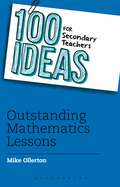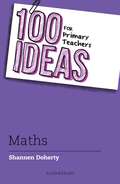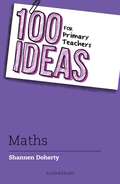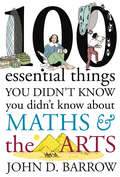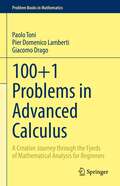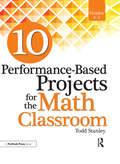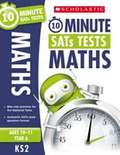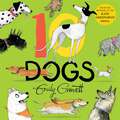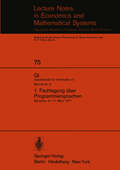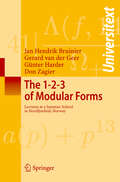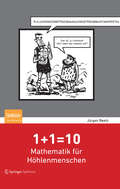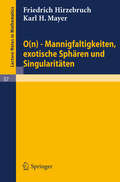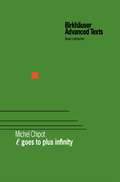- Table View
- List View
100 Ideas for Secondary Teachers: Outstanding Mathematics Lessons (100 Ideas for Teachers)
by Mike Ollerton100 IDEAS: QUICK - EASY - INSPIRED - OUTSTANDINGTeaching mathematics in the secondary school can be very demanding especially with the extra pressure of 'no notice' Ofsted inspections. In this fully updated book Mike Ollerton offers strategies and activities for you to integrate into your everyday teaching to ensure your lessons are consistently outstanding and include all the mathematics skills secondary students need to study. Topics include algebra, fractions, geometry and measurement, as well as domino and dice games and an exciting study of Fibonacci. Many of the ideas start from a very simple concept that can be developed into more challenging mathematics, allowing you to differentiate your teaching to inspire, challenge and motivate every student in your class. The book includes step-by-step instructions, diagrams to exemplify the techniques and teaching tips for the best ways to put the activities into practice. Your biggest problem will be deciding which idea to use first! Mike Ollerton has taught for 25 years in secondary schools and is now working as a teacher trainer.
100 Ideas for Primary Teachers: Maths (100 Ideas for Teachers)
by Shannen DohertyOffering 100 fun, practical ideas for teaching primary maths, this is the perfect resource for teachers looking for creative ways to vary their practice. The activities cover the entire maths National Curriculum for Key Stages 1 and 2, from number and place value to fractions, measurement, geometry and algebra. The ideas are rooted in a mastery approach and are designed to support both struggling and able learners, but they can easily be embedded into any teaching method and work brilliantly in all classrooms.Whether you're looking to grow your confidence, find new inspiration or simply need one-off ideas, this is a must-have toolkit for you. From teaching proportion using playing cards to setting up a classroom shop to practise currency calculations, this book includes games, starters and open-ended investigations as well as tips for stretch and challenge. These ideas are designed to save teachers time, keep all children engaged and put the magic back into maths.Written by experts in their field, the 100 Ideas books offer practical ideas for busy teachers. They include step-by-step instructions, teaching tips and taking it further ideas. Follow the conversation on Twitter using #100Ideas.
100 Ideas for Primary Teachers: Maths (100 Ideas for Teachers)
by Shannen DohertyOffering 100 fun, practical ideas for teaching primary maths, this is the perfect resource for teachers looking for creative ways to vary their practice. The activities cover the entire maths National Curriculum for Key Stages 1 and 2, from number and place value to fractions, measurement, geometry and algebra. The ideas are rooted in a mastery approach and are designed to support both struggling and able learners, but they can easily be embedded into any teaching method and work brilliantly in all classrooms.Whether you're looking to grow your confidence, find new inspiration or simply need one-off ideas, this is a must-have toolkit for you. From teaching proportion using playing cards to setting up a classroom shop to practise currency calculations, this book includes games, starters and open-ended investigations as well as tips for stretch and challenge. These ideas are designed to save teachers time, keep all children engaged and put the magic back into maths.Written by experts in their field, the 100 Ideas books offer practical ideas for busy teachers. They include step-by-step instructions, teaching tips and taking it further ideas. Follow the conversation on Twitter using #100Ideas.
100 Essential Things You Didn't Know You Didn't Know About Maths and the Arts
by John D. BarrowWhat can maths tell us about art and design?Professor John D. Barrow has all the answers. In 100 Essential Things You Didn't Know You Didn't Know About Maths and the Arts, he shows us that mathematics and the arts are not so far removed from each other. He takes us on a 100-step tour, guiding us through art forms as various as sculpture, literature, architecture and dance, and reveals what maths can tell us about the mysteries of the worlds of art and design.We find out why diamonds sparkle, how many words Shakespeare knew and why the shower is the best place to sing. We discover why an egg is egg-shaped, why Charles Dickens crusaded against maths and how a soprano can shatter a wine glass without touching it... Enlivening the everyday with a new way of looking at the world, this book will enrich your understanding of the maths and art that surround us in our day-to-day lives.
100+1 Problems in Advanced Calculus: A Creative Journey through the Fjords of Mathematical Analysis for Beginners (Problem Books in Mathematics)
by Paolo Toni Pier Domenico Lamberti Giacomo DragoThis book convenes a collection of carefully selected problems in mathematical analysis, crafted to achieve maximum synergy between analytic geometry and algebra and favoring mathematical creativity in contrast to mere repetitive techniques. With eight chapters, this work guides the student through the basic principles of the subject, with a level of complexity that requires good use of imagination.In this work, all the fundamental concepts seen in a first-year Calculus course are covered. Problems touch on topics like inequalities, elementary point-set topology, limits of real-valued functions, differentiation, classical theorems of differential calculus (Rolle, Lagrange, Cauchy, and l’Hospital), graphs of functions, and Riemann integrals and antiderivatives. Every chapter starts with a theoretical background, in which relevant definitions and theorems are provided; then, related problems are presented. Formalism is kept at a minimum, and solutions can be found at the end of each chapter.Instructors and students of Mathematical Analysis, Calculus and Advanced Calculus aimed at first-year undergraduates in Mathematics, Physics and Engineering courses can greatly benefit from this book, which can also serve as a rich supplement to any traditional textbook on these subjects as well.
10 x 10 graph (tactile)
by Adrian FarnsworthThis page shows a blank graph with a grid and the Y and X-axis labelled to the left and bottom.
10 x 10 graph (large print)
by Adrian FarnsworthThis page shows a blank graph with a grid and the Y and X-axis labelled to the left and bottom.
10 x 10 blank grid (tactile)
by Adrian FarnsworthThese pages each show an image of a grid with tick marks to the left and bottom. The first page has a grid of thick black lines, the second page has a grid of thick grey lines, the third a grid of thin grey lines, the fourth a grid of spaced black dotted lines, the fifth a grid of black dotted lines, the sixth a grid of fine dotted lines, the seventh a grid of grey dotted lines, the eighth a grid of black dots, the ninth a grid of grey dots, and the last a grid of small black dots.
10 Performance-Based Projects for the Math Classroom: Grades 3-5
by Todd StanleyEach book in the 10 Performance-Based Projects series provides 10 ready-made projects designed to help students achieve higher levels of thinking and develop 21st-century skills. Projects are aligned to the Common Core State Standards, allowing students to explore and be creative as well as gain enduring understanding. Each project represents a type of performance assessment, including portfolios, oral presentations, research papers, and exhibitions. Included for each project is a suggested calendar to allow teacher scheduling, mini-lessons that allow students to build capacity and gain understanding, as well as multiple rubrics to objectively assess student performance. The lessons are presented in an easy-to-follow format, enabling teachers to implement projects immediately.Grades 3-5
10 Performance-Based Projects for the Math Classroom: Grades 3-5
by Todd StanleyEach book in the 10 Performance-Based Projects series provides 10 ready-made projects designed to help students achieve higher levels of thinking and develop 21st-century skills. Projects are aligned to the Common Core State Standards, allowing students to explore and be creative as well as gain enduring understanding. Each project represents a type of performance assessment, including portfolios, oral presentations, research papers, and exhibitions. Included for each project is a suggested calendar to allow teacher scheduling, mini-lessons that allow students to build capacity and gain understanding, as well as multiple rubrics to objectively assess student performance. The lessons are presented in an easy-to-follow format, enabling teachers to implement projects immediately.Grades 3-5
10 Minute Sats Tests: Maths - Ages 10-11 Year 6 (PDF)
by Tim HandleyJust like the real thing - only shorter!<br> <br> Help your child prepare for the SATS with these bite-sized National test papers. This book offers 12 mini-tests - including Reasoning and Arithmetic papers. Question types and mark schemes match the format of the National tests and offer an authentic SATs experience, though the flexible format allows them to be used at any time of the day. <br> A handy progress chart is also supplied to give you some indication of the scores your child is likely to attain. A skills check section will also help you to identify all of the key maths skills your child needs to be successful in the SATs tests.
10 Dogs
by Emily GravettTen gorgeous dogs chase, hide and play with ten juicy sausages in this funny, original book about numbers by the multi-award-winning, bestselling Emily Gravett.Bursting with energy and fun, young children will love to count the dogs and the sausages, as well as looking out for all the funny details on each page. The book explores numbers one going up to ten, and ten going down to zero, touching on several simple concepts like half, all, more, less along the way.A brilliant companion to Emily's book about counting, colours and cats, 10 Cats.
1 to 2 scale (large print)
by Adrian FarnsworthThis page shows a scale marked every tenth and labelled in giant print at the 0, 1 and 2 points
1 to 100 number square (tactile)
by Adrian FarnsworthThe Large Print page shows two squares each containing smaller squares numbered 1 to 100 in large print. The Braille pagenbsp;shows a square containing smaller squares numbered 1 to 100 in braille.
1. Fachtagung über Programmiersprachen: München, 9.–11. März 1971 (Lecture Notes in Economics and Mathematical Systems #75)
by Hans Langmaack Manfred Paul1-50 number cards (tactile)
by Adrian FarnsworthThese seven pages show numbers from1 to 50 in large print and braille on a grid, each divided by vertical and horizontal lines so they can be cut up to make individual cards with one number on each.
The 1-2-3 of Modular Forms: Lectures at a Summer School in Nordfjordeid, Norway (Universitext)
by Jan Hendrik Bruinier Gerard van der Geer Günter Harder Don ZagierThis book grew out of three series of lectures given at the summer school on "Modular Forms and their Applications" at the Sophus Lie Conference Center in Nordfjordeid in June 2004. The first series treats the classical one-variable theory of elliptic modular forms. The second series presents the theory of Hilbert modular forms in two variables and Hilbert modular surfaces. The third series gives an introduction to Siegel modular forms and discusses a conjecture by Harder. It also contains Harder's original manuscript with the conjecture. Each part treats a number of beautiful applications.
1+1=10: Mathematik für Höhlenmenschen
by Jürgen BeetzMehr als die einfache Logik eines Frühmenschen brauchen Sie nicht, um die Grundzüge der Mathematik zu verstehen. Denn Sie treffen in diesem Buch viele einfache, fast gefühlsmäßig zu erfassende mathematische Prinzipien des täglichen Lebens. Deswegen kann der Autor bei seinem Versuch, die Mathematik „begreiflich“ zu machen, in die Steinzeit zurückgehen – genauer gesagt: etwa in die Jungsteinzeit, 10.000 Jahre vor unserer Zeitrechnung. Ackerbau und Viehzucht hatten schon begonnen. Dort treffen Sie Eddi Einstein, den Denker und Rudi Radlos, den Erfinder – die Hauptakteure. Ein dritter Geselle ist Siggi Spökenkieker, der Druide und Seher. Siggi ist mit der Gabe der Präkognition gesegnet. So können wir Eddi, den Denker, mit Erkenntnissen ausstatten, die erst Jahrtausende später von bedeutenden Philosophen und Mathematikern erlangt worden waren. Die wahre Meisterin dieser Wissenschaftsdisziplin ist jedoch Wilhelmine Wicca. Sie war so klug wie die drei Kerle zusammen. Deshalb galt sie auch als Hexe – was damals ein Ehrentitel war – und als weise Frau.
0 to 100 rule (tactile)
by Adrian FarnsworthThis page shows a rule numbered from 0 to 100 in tens. There is a duplicate of it in the bottom half of the page.
0 to 100 Rule (Large Print)
by Adrian FarnsworthThis page shows a rule numbered from 0 to 100 in tens. There is a duplicate of it in the bottom half of the page.
0-100 number cards (tactile)
by Adrian FarnsworthThese seven pages show numbers from 0 to 100 in large print and braille on a grid, each divided by vertical and horizontal lines so they can be cut up to make individual cards with one number on each.
0-10 grid (tactile)
by Adrian FarnsworthThis page shows a grid numbered from 0 to 10 in units of one on the X and Y-axis.
ℓ Goes to Plus Infinity (Birkhäuser Advanced Texts Basler Lehrbücher)
by Michel ChipotThis book provides proofs of the asymptotic behavior of solutions to various important cases of linear and nonlinear problems in the theory of elliptic and parabolic partial differential equations. It is a valuable resource for graduates and researchers in applied mathematics and for engineers. Many results presented here have not been published elsewhere. They will motivate and enable the reader to apply the theory to other problems in partial differential equations.
